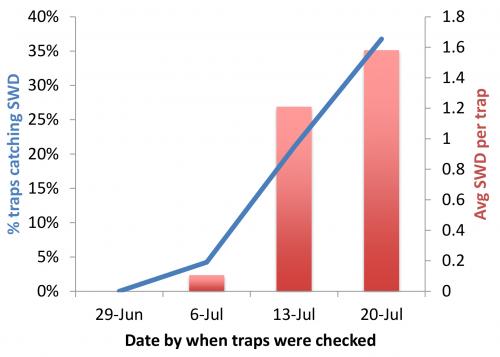Michigan spotted wing Drosophila report for July 21, 2015
Summer increase of spotted wing Drosophila continues in southern Michigan.
This is the sixth weekly report of the Michigan State University Extension spotted wing Drosophila (SWD) monitoring network. The summer increase of SWD continues across southern Michigan and is just beginning in northwest Michigan (see graph). Approximately 117 females and 100 males for a total of 215 were captured in 50 traps out of the more than 130 traps being monitored as part of the network. This is a 30 percent increase from the 167 total SWD that were captured last week. Ripening, thin-skinned fruit such as blueberries, raspberries and cherries are the most vulnerable to infestation. Additionally, berries produced by a number of wild fruiting trees and shrubs such as black raspberries, honeysuckle and mulberry can be infested. Growers and scouts should be on their guard with susceptible fruit crops that are beginning to ripen.

Average number of spotted wing Drosophila flies caught in traps in four Michigan fruit production regions. NW represents 67 traps in Antrim, Benzie, Grand Traverse, Leelanau and Manistee counties. SE represents 12 traps across Genesee, Ingham, Lapeer, Lenawee, Livingston, Macomb, Monroe and Oakland counties. SW represents 43 traps across Allegan, Berrien, Kalamazoo, Ottawa and Van Buren. WC represents 17 traps in Ionia, Kent, Mecosta and Oceana.

Average number of spotted wing Drosophila (SWD) captured per trap (red bars) and the percentage of traps that captured any SWD (blue line) across the entire trapping network by week starting in June 29, 2015.
Trap location has a big effect on the number of SWD captured, so these following statements are for guidance only. Trapping in your own fields is the best way to know what’s happening on your farm. A few more traps in the northwest captured SWD this week than last week – in Antrim County at the edge of sweet cherry orchards, near tart cherry in Benzie County, near sweet and tart cherry orchards in Grand Traverse County and near a tart cherry orchard in Leelanau County. In the southeast, SWD were caught near Ingham County grape and raspberry plantings, near Lenawee County tart cherry, near Livingston County sweet cherry, near Macomb County sweet cherry, near Monroe County tart cherry and near Oakland County raspberry. In the southwest, SWD were captured in Allegan County near blueberry, grape and tart cherry, Berrien County blueberry, grape, raspberry, strawberry and tart cherry, Ottawa County blueberry and raspberry and Van Buren County plum, raspberry and tart cherry. In west central, SWD were captured in Ionia County blueberry, Kent County sweet and tart cherry and Mecosta County raspberry and strawberry.
Traps in the network are baited with Trece lures and placed near susceptible crops and wild hosts in each of the major fruit growing regions across the state. Commercial plantings include strawberries, blueberries, raspberries, grapes, tart and sweet cherries, peaches and plums. Wild hosts in the trapping network include autumn olives, black cherries, pin cherries, choke cherries, blackberries, honeysuckle, mulberries and wild grapes.
Additional trap networks in the state that are baited with other lures including a yeast-sugar mix are also trapping SWD flies, often in higher numbers than the Trece lures. This just reiterates the importance of protecting fruit that is in the ripening or ripe stage as the SWD population is clearly on the upswing.
For instructions on how to construct your own traps and use them for monitoring for SWD, please visit the MSU Spotted Wing Drosophila website. For specific recommendations about managing SWD in berry crops, please see “Increase of spotted wing Drosophila in berry crops.”



 Print
Print Email
Email


